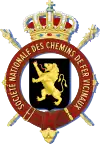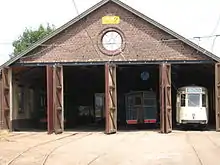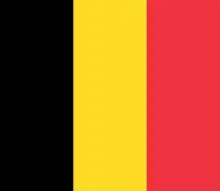| National Company of Light Railways | |
|---|---|
 Coat of arms of the National Company of Light Railways | |
 Tram in Ostend, 1982 | |
| Overview | |
| Native name | Nationale Maatschappij Van Buurtspoorwegen (NMVB) Société Nationale des Chemins de fer Vicinaux (MIVB) Nationale Kleinbahngesellschaft (NKG) |
| Locale | Belgium |
| Transit type | tramway, railway |
| Operation | |
| Began operation | May 29, 1884 |
| Ended operation | December 31, 1991 |
The National Company of Light Railways[1] (Dutch: Nationale Maatschappij Van Buurtspoorwegen, abbreviated as NMVB; French: Société Nationale des Chemins de fer Vicinaux, abbreviated as SNCV)[1] was a state-owned transportation provider which comprised a system of narrow-gauge tramways or local railways in Belgium,[1] which covered the whole country, including the countryside, and had a greater route length than the mainline railway system.[2] They were 1,000 mm (3 ft 3+3⁄8 in) metre gauge and included electrified city lines and rural lines using steam locomotives and diesel railcars; half the system was electrified.
The company gradually switched to buses and dismantled the tram tracks. Only the coastal line, the Charleroi metro, and the short line to the caves at Han-sur-Lesse are still in commercial use; four museums hold significant collections of rolling stock, including the museum at Schepdaal and the ASVi museum in Thuin. The longest (11 km (6.8 mi)) and oldest (40 years) tourist tramway is the Tramway Touristique de l'Aisne (TTA), between Érezée and Dochamps. A sponsoring group called "Tramania" has supported various tramway preservation initiatives for 13 years, in particular by financing the construction of the Thuin museum and car restoration for TTA.
History

Legislation allowing the construction of rural tramways was passed in 1875, followed by a new law in 1885. The result was the creation of the nationwide operator named "National Company of Light Railways", known as Nationale Maatschappij van Buurtspoorwegen (NMVB) in Dutch and Société Nationale des Chemins de fer Vicinaux (SNCV) in French.[1] The majority of lines were 1,000 mm (3 ft 3+3⁄8 in) metre gauge, although until 1921 many in the Antwerp metropolitan area were 1,067 mm (3 ft 6 in) gauge, later re-gauged.[2] Many lines were built alongside roads, and carried considerable quantities of freight (especially timber and agricultural produce) as well as passengers.[2]
World War I and World War II saw greatly increased traffic despite some wartime damage. The non-electric network reached a peak of approximately 3,938 kilometres (2,447 mi) in 1925, but soon parts started to close as usage of buses, lorries, and electric trams increased. Starting from 1924, the NMVB/SNCV started to operate buses (either owned or hired).[3] At this time, the electric tramway network was already 523 kilometres (325 mi) in length. In 1939, the NMVB/SNCV operated 161 regular bus lines amounting to 279 kilometres (173 mi).
After World War II lorries, buses, and cars deprived the trams of much of their business. The electric network reached a peak of 1,528 kilometres (949 mi) in 1950. The whole network (electric and non-electric) was still approximately 4,236 kilometres (2,632 mi) in length (the peak of 4,811 kilometres (2,989 mi) was in 1945), but by 1960 had been reduced to only 977 kilometres (607 mi). On several rural lines, passenger tramways were replaced by buses but SNCV/NMVB kept running freight trams until it wasn't profitable anymore. In 1977, the buses of the Belgian railways (SNCB/NMBS) were transferred to SNCV/NMVB. The tramways from Brussels to Wemmel, Koningslo and Grimbergen closed in 1978.
Political federalism within Belgium from 1980 onwards saw the splitting of many national institutions into separate bodies for Flanders, Wallonia, and the Brussels-Capital Region. SNCV/NMVB was broken up in 1991 into De Lijn (for Flanders) and TEC (for Wallonia), both companies were now primarily operating buses. De Lijn inherited the tram systems in Ghent and Antwerp (including the Pre-metro), operated previously by local companies MIVG and MIVA respectively, and the coastal tramway. TEC operates the Charleroi Pre-metro, which includes sections of Vicinal track. STIB/MIVB operates the 1,435 mm (4 ft 8+1⁄2 in) standard gauge Brussels Metro, tram, and bus network.
Gallery
 Train signal
Train signal "Tramparade 125 years of vicinal railways", 4th tram of the parade
"Tramparade 125 years of vicinal railways", 4th tram of the parade
![Steam tram in Tourinnes-Saint-Lambert [fr]](../I/Tourinnes_bew.jpg.webp) Steam tram in Tourinnes-Saint-Lambert
Steam tram in Tourinnes-Saint-Lambert Alle (fr) station building, just outside village, now used as a local office for the Société Régionale Wallonne du Transport
Alle (fr) station building, just outside village, now used as a local office for the Société Régionale Wallonne du Transport Steam tram locomotive.
Steam tram locomotive.
See also
References
- 1 2 3 4 Nerincx, Alfred (January 1902). "The National Company of Light Railways in Belgium" (PDF). Annals of the American Academy of Political and Social Science. SAGE Publications in association with the American Academy of Political and Social Science. 19 (Commerce and Transportation): 108–113. ISSN 1552-3349. JSTOR 1009818. Retrieved 14 July 2022.
- 1 2 3 De Block, Greet (2015). "Urbanizing the Countryside: Rails, Workers and Commuting in South-West Flanders, Belgium, 1830–1930". In Divall, Colin (ed.). Cultural Histories of Sociabilities, Spaces and Mobilities (1st ed.). London and New York: Routledge. pp. 53–66. doi:10.4324/9781315653839. ISBN 9781315653839.
- ↑ "De eerste NMVB busdiensten | Tijdlijn | Zone 01". www.z one01.be. Retrieved 2020-01-25.
External links
- Tramway Touristique Lobbes-Thuin
- Tramway Touristique de l'Aisne
- Photo archives of the Vicinal tramways
- Vicinal tram history and preservation activities
- Trambelgium (with NMVB/SNCV history)
- Tram Travels: Vicinal tramway (NMVB/SNCV)
- Documents and clippings about National Company of Light Railways in the 20th Century Press Archives of the ZBW
